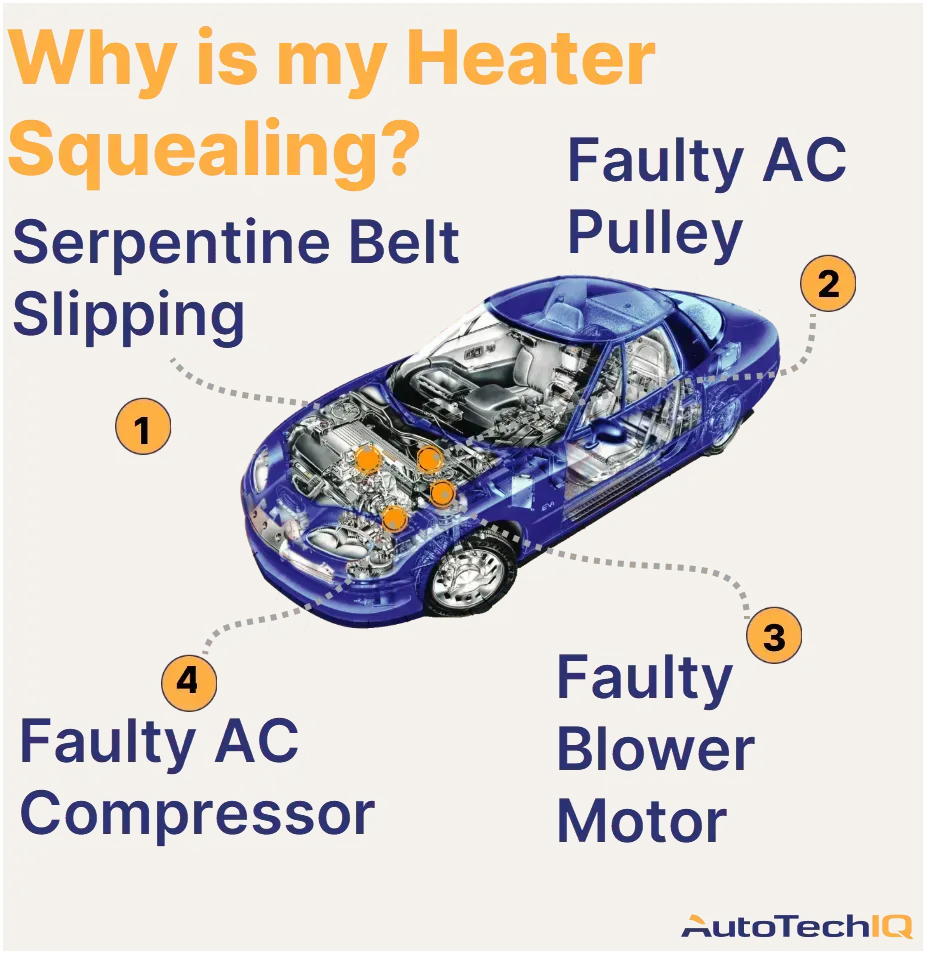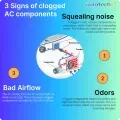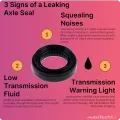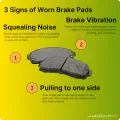
If the squealing seems to come from your car’s hood the issue is a loose serpentine belt. But, if the squealing sound comes directly from the heater, it’s probably a faulty blower motor.
The serpentine belt can be at fault because it`s a belt under your vehicle hood that rotates with the heater`s pulley. If the belt is misaligned, it`ll spin erratically on the pulley, causing a squealing noise.
If the issue is a faulty blower motor, then your heater has internal issues affecting the fan motor and fan speed. The blower motor is part of your HVAC module that blows cold air (if you toggled the AC) or hot air (if you toggled the heater). If the motor is faulty, it`ll struggle to operate, which commonly results in squealing noises from the vents.
Watch out: The squealing noise can mean serious electrical issues if it’s related to the serpentine belt or the blower motor. Therefore, ignoring this condition can lead to multiple electrical failures and damage progression.
The heater isn’t working properly if it’s making a squealing noise; if you’re hearing this type of noise when turning the heater on, be quick to fix it; the noise might seem like it's coming from the glove box. Here are some of the main risks possibly related to it:
-
Serpentine problems: The serpentine belt could be misaligned or out of place. This means the belt is either loose or banging against other components. Since the belt is vital for many of the vehicle’s systems, this could lead to various problems beyond the AC squealing noise. Moreover, a loose serpentine belt can damage nearby components.
-
Electrical Issues: Since the serpentine belt works along the alternator, it can lead to alternator issues if faulty. The alternator feeds many of your vehicle`s systems, so if it fails, you might lose the radio, power steering, cabin lights, headlights, etc. If the blower motor is faulty, it`ll put extra stress on other HVAC components, resulting in more expenses and electrical failures.
-
Health Concerns: A loose serpentine belt can burn and deteriorate under your vehicle`s hood if it bangs around hot components. This creates a fire hazard. A faulty blower motor can damage your HVAC`s airflow, leading to mold and dust inside the AC system. This can trigger allergies and breathing problems.
The most common causes for a car heater squealing
Here are the most common issues causing your car heater to squeal:
-
Faulty Blower Motor / Blower motor fan
Frequently Asked Questions
Q: Can I keep driving after my heater squealed?
You can continue driving after your heater squeals, but it's important to address the issue as soon as possible. While the noise itself may not immediately stop your car from running, it could be a sign of a failing blower motor, a worn belt, or debris in the HVAC system, any of which could lead to more serious problems if left unchecked. For example, the serpentine belt could snap, which will leave you stranded.
Q: How long do vehicle heaters last?
Vehicle heaters typically last the lifetime of the car, but their components can wear out or fail over time. The heater core, which is the main component, can last anywhere from 10 to 15 years or longer if properly maintained. However, other parts of the heating system, such as the blower motor, heater control valve, or thermostat, may require replacement after 8 to 10 years, depending on usage and maintenance.
Typical fixes to address the cause(s)
These are typical processes and repair services that fix a burning rubber issue
-
Serpentine Belt Replacement
-
AC Compressor Replacement
-
Air conditioning system flush
-
Heater fan replacement
-
Blower Motor Replacement
The most common cause: Slipping Serpentine Belt
The most common reason for a car making squealing noises when enabling the heater is because of a slipping serpentine belt. When engaging the heater, the AC Compressor’s pulley gets with the belt, so it spins and generates energy. However, since the belt is misaligned, the compressor’s pulley becomes wobbly with the serpentine belt’s crooked movements, generating a squealing sound.
-
Origin of the sound: Under the hood
-
Symptoms it causes: Apart from the squealing noise you might notice low airflow when engaging the AC and heater. You might also notice the engine overheating.
-
High risk of priority: The serpentine belt is vital for many electrical components in your car, including the radio, cabin lights, AC, etc., if the belt is slipping, then it’s at risk of snapping out of place; if that happens, you’ll get stranded.
What exactly is a serpentine belt?
The serpentine belt, also known as the accessory belt, is a rubber belt under your vehicle hood. The belt spins next to the engine, moving on different pulleys for various components. The serpentine belt movement is triggered by the engine and helps deliver power to the car’s accessories.
-
Key function: In short, the key function of the serpentine belt is to receive engine power and start spinning, rotating the pulleys of components like the alternator, power steering pump, air conditioning compressor, and sometimes the water pump. This rotation feeds the electrical system and helps power your car’s A/C, radio, accessories, lights, etc.
Although the serpentine belt commonly causes squealing noises in a vehicle, do not assume it’ll be always the case. Other car parts related to the HVAC can lead to a squealing sound when the heater goes active.
Go safe: Ask for a mechanic to inspect your vehicle to track the squealing sound’s location and how it affects other components. Many shops do transparent vehicle inspections and lay out your options after investigating your vehicle’s conditions.
What’s a vehicle inspection? It’s “detective work” on your vehicle, checking its systems to find if anything is preventing the car from working as expected. In this case, mechanics examine different parts of your vehicle to track where the squealing noise is coming from and what’s causing it. They’ll also check the condition of components during their inspection, noting which are causing the problem and which got affected by it, recommending to replace them in order of priority.
Transparency example in a serpentine belt service
Let’s see how a vehicle inspection defines the car service needed to fix a serpentine belt problem. In many cases, the serpentine belt issue is discovered because of a squealing noise from the heater or the AC.
In this example, the customer reported hearing a squealing noise coming from the vehicle’s front part when activating the heater. The mechanic inspected under the vehicle’s hood, finding that the serpentine belt was misaligned. Since the AC compressor engages with the belt when the heater is activated, the technician made a test. When activating the heater, the technician saw how the AC compressor’s pulley would behave with the serpentine belt.
The serpentine belt was, in a wobbly fashion, engaging with the compressor’s pulley, resulting in erratic movements and a squealing sound.
With the sound source found, the technician will inspect the surrounding components that the serpentine belt also engages with to check for any further damage.
The image below shows the technician’s photo, where they recorded the issue and added explanatory text.

In this case, the mechanic put the “Immediate Action” tag on the serpentine belt.
Other news
-
Car is Squealing When Driving

-
What is Preventative Maintenance and What Are The Benefits of it?

-
JobViewIQ - DVI Process Training - Part of the Auto Care Alliance Benefits

-
7 Signs of Clogged AC Components

-
How Much Does a Transmission Fluid Change Cost?

-
7 Signs of a Leaking Axle Seal

-
8 Signs of a Bad Brake Pad
